Abstract
It has been recently proposed that 11 beta-hydroxysteroid dehydrogenase (11 beta-OHSD) is responsible for aldosterone tissue specificity. A 11 beta-OHSD deficiency has been invoked as a cause of the syndrome of apparent mineralocorticoid excess, and 11 beta-OHSD inhibition by liquorice has been invoked to explain the hypertension induced by this drug. Since the renal tubule is composed of aldosterone-sensitive and insensitive segments, we determined the distribution of 11 beta-OHSD along the rabbit tubule. Pools of tubular segments isolated by microdissection were incubated for 2 h at 37 degrees C in the presence of [3H]corticosterone (3H-B, 8.10(-9) M). Afterwards, the amounts of 3H-B and of the metabolite 11-dehydrocorticosterone (3H-A) were determined using HPLC analysis. In the proximal tubule, in either its convoluted or straight portion, and in the medullary thick ascending limb, the amount of 3H-A was 19.6 +/- 3.8% (n = 12), 17.9 +/- 3.4 (n = 8), and 15.0 +/- 2.2 (n = 4), respectively, of the sum of 3H-A + 3H-B. In the cortical ascending limb and the collecting tubule in its cortical and medullary parts, it was 74.7 +/- 6.8% (n = 4), 74.1 +/- 4.9 (n = 9) and 64.6 +/- 14.1 (n = 3), respectively. In both proximal and cortical collecting tubule, addition of carbenoxolone 8.10(-4) M, an inhibitor of 11 beta-OHSD, almost completely inhibited the conversion of 3H-B to 3H-A. Thus, 11 beta-OHSD activity was high in the aldosterone-sensitive segments, and low in the aldosterone-insensitive segments. These results strongly favor the hypothesis that 11 beta-OHSD is a key enzyme in mineralocorticoid tissue specificity along the rabbit nephron. They reinforce the notion that a defect in 11 beta-OHSD plays a major role in the syndrome of apparent mineralocorticoid excess and liquorice-induced hypertension.
Full text
PDF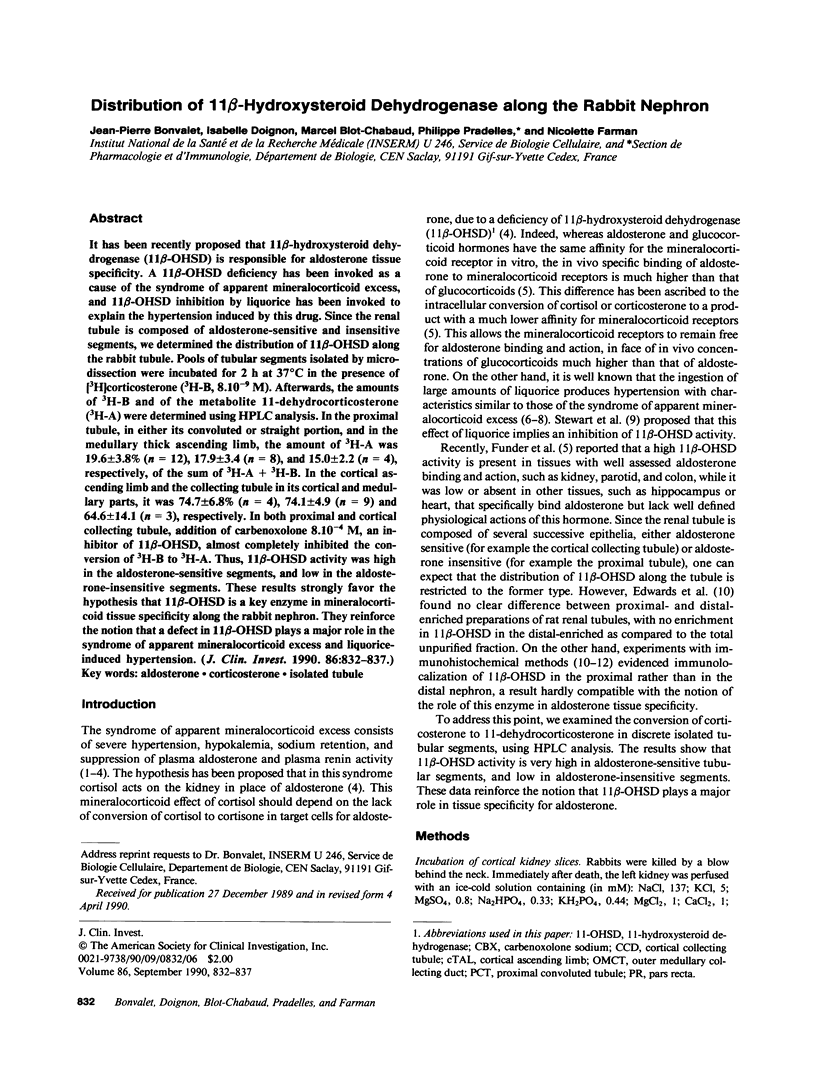
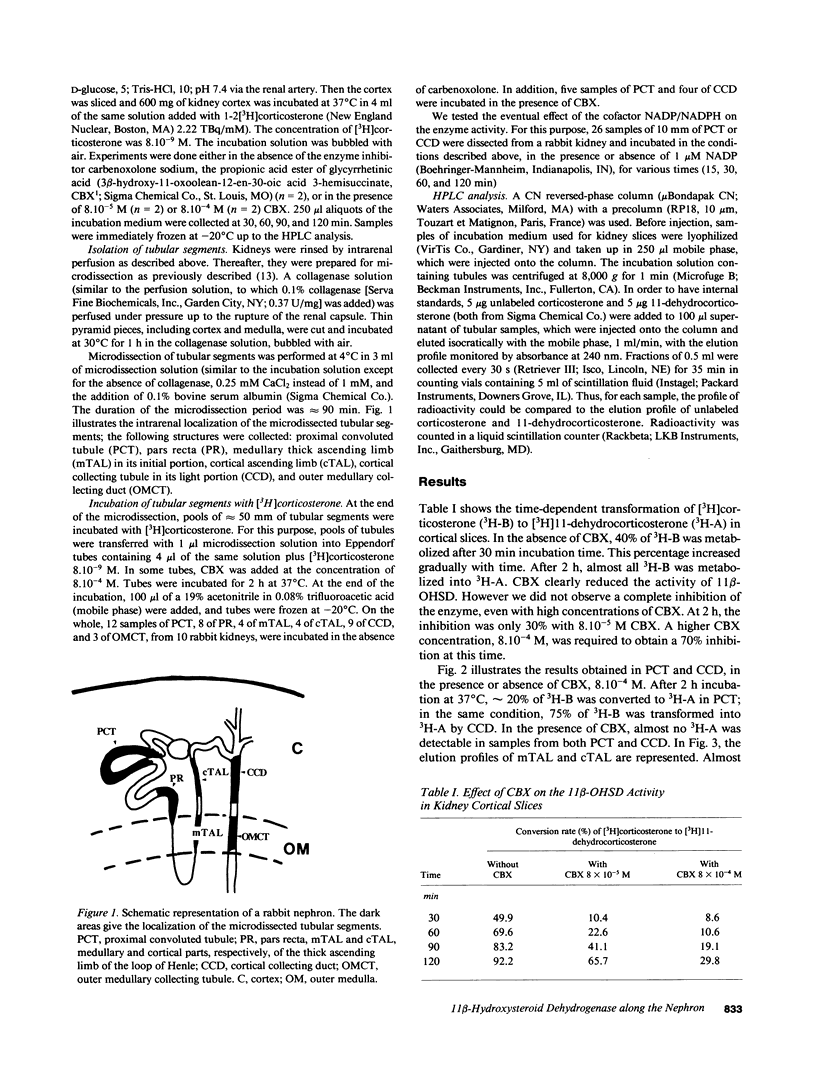
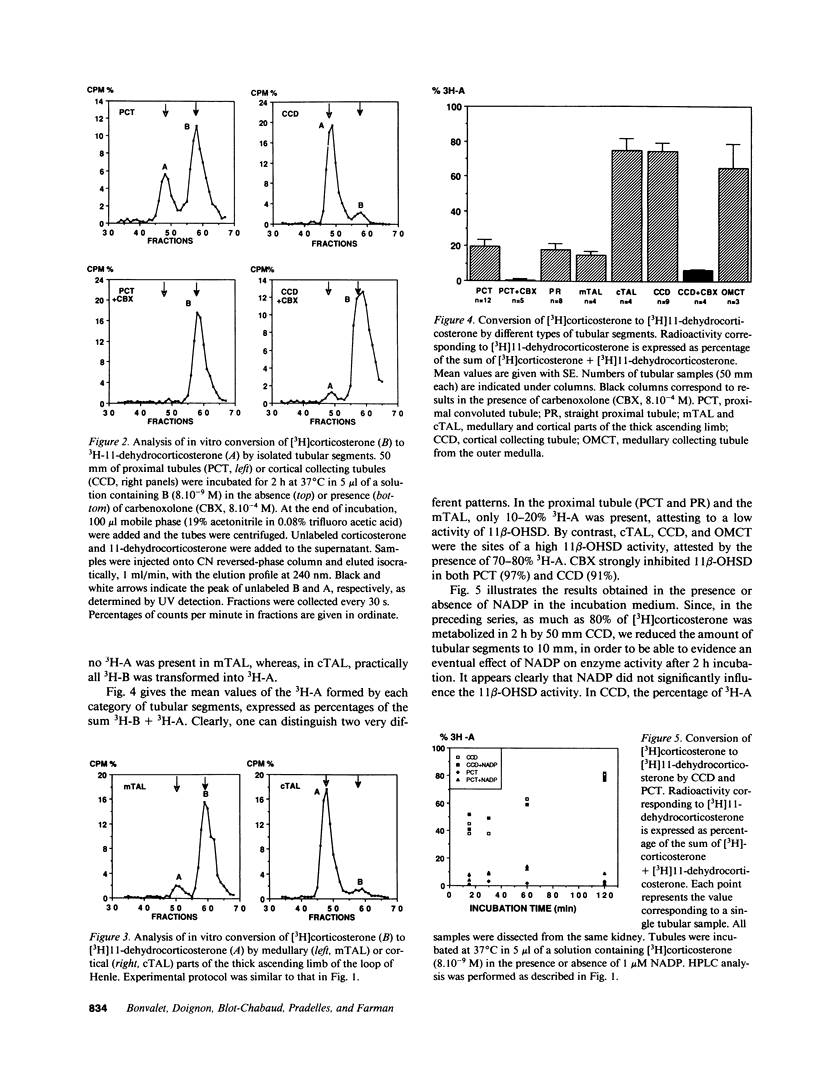
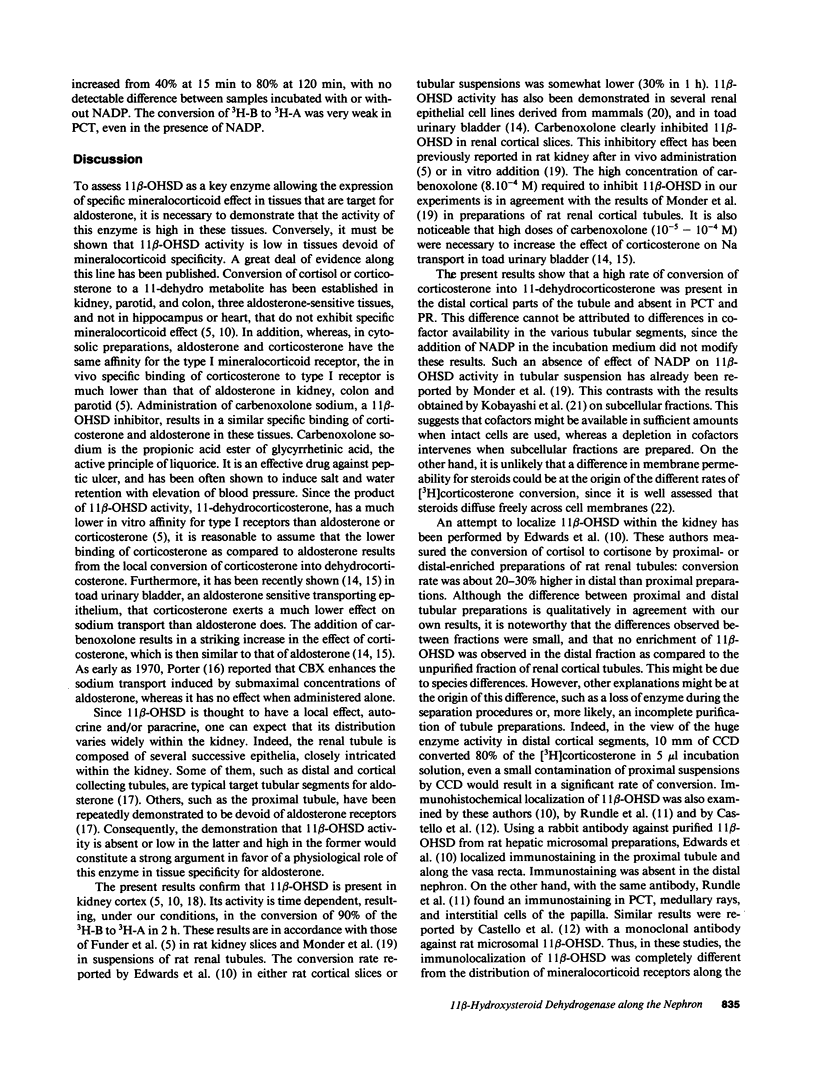
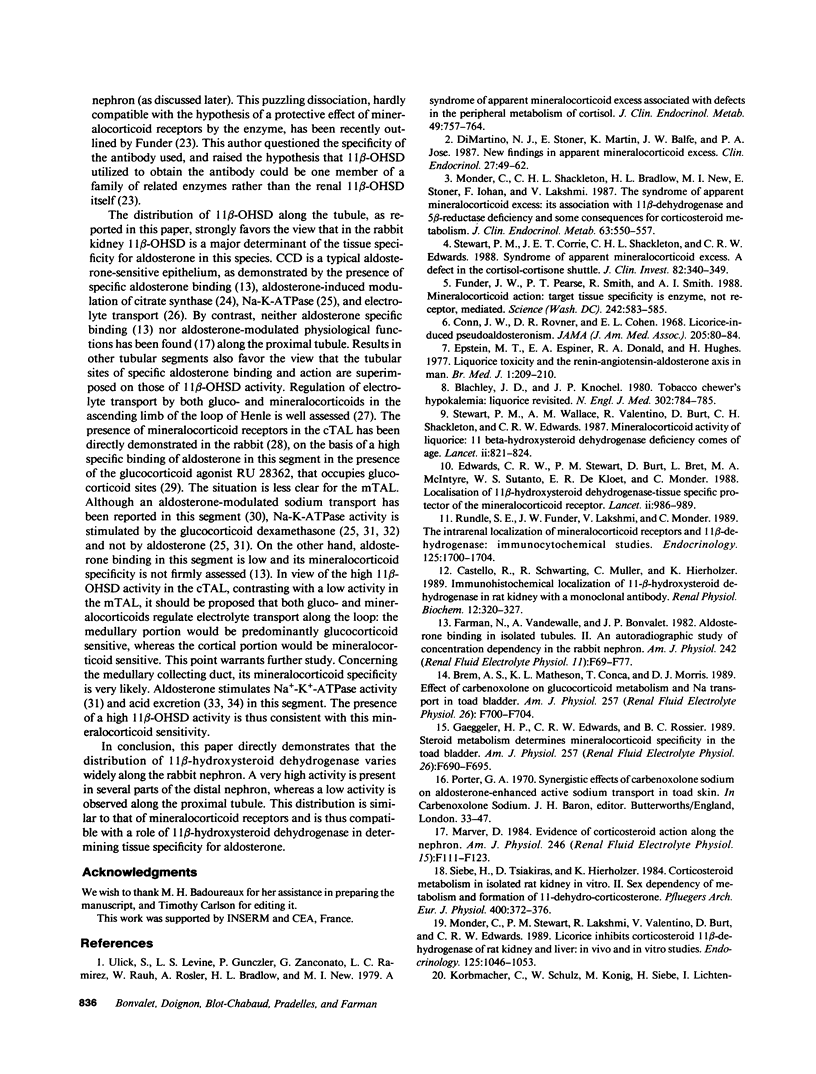
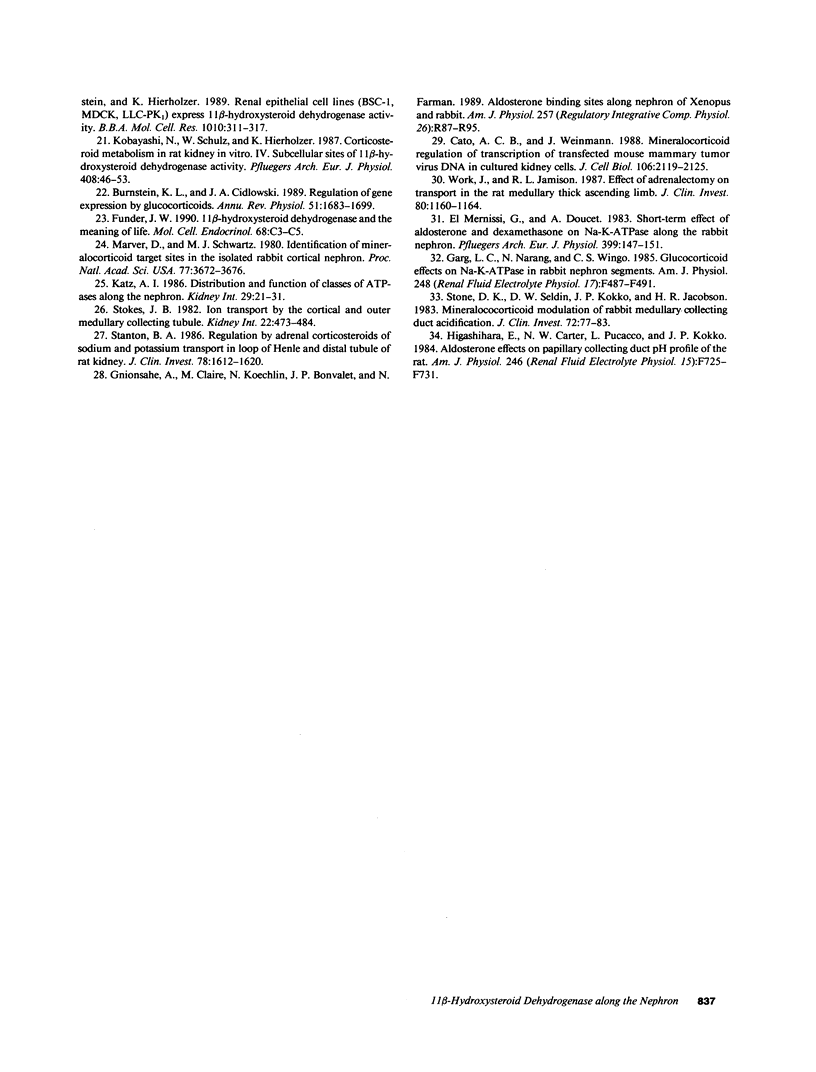
Selected References
These references are in PubMed. This may not be the complete list of references from this article.
- Blachley J. D., Knochel J. P. Tobacco chewer's hypokalemia: licorice revisited. N Engl J Med. 1980 Apr 3;302(14):784–785. doi: 10.1056/NEJM198004033021405. [DOI] [PubMed] [Google Scholar]
- Brem A. S., Matheson K. L., Conca T., Morris D. J. Effect of carbenoxolone on glucocorticoid metabolism and Na transport in toad bladder. Am J Physiol. 1989 Oct;257(4 Pt 2):F700–F704. doi: 10.1152/ajprenal.1989.257.4.F700. [DOI] [PubMed] [Google Scholar]
- Castello R., Schwarting R., Müller C., Hierholzer K. Immunohistochemical localization of 11-hydroxysteroid dehydrogenase in rat kidney with monoclonal antibody. Ren Physiol Biochem. 1989 Sep-Dec;12(5-6):320–327. doi: 10.1159/000173209. [DOI] [PubMed] [Google Scholar]
- Cato A. C., Weinmann J. Mineralocorticoid regulation of transcription of transfected mouse mammary tumor virus DNA in cultured kidney cells. J Cell Biol. 1988 Jun;106(6):2119–2125. doi: 10.1083/jcb.106.6.2119. [DOI] [PMC free article] [PubMed] [Google Scholar]
- DiMartino-Nardi J., Stoner E., Martin K., Balfe J. W., Jose P. A., New M. I. New findings in apparent mineralocorticoid excess. Clin Endocrinol (Oxf) 1987 Jul;27(1):49–62. doi: 10.1111/j.1365-2265.1987.tb00838.x. [DOI] [PubMed] [Google Scholar]
- Edwards C. R., Stewart P. M., Burt D., Brett L., McIntyre M. A., Sutanto W. S., de Kloet E. R., Monder C. Localisation of 11 beta-hydroxysteroid dehydrogenase--tissue specific protector of the mineralocorticoid receptor. Lancet. 1988 Oct 29;2(8618):986–989. doi: 10.1016/s0140-6736(88)90742-8. [DOI] [PubMed] [Google Scholar]
- El Mernissi G., Doucet A. Short-term effects of aldosterone and dexamethasone on Na-K-ATPase along the rabbit nephron. Pflugers Arch. 1983 Oct;399(2):147–151. doi: 10.1007/BF00663911. [DOI] [PubMed] [Google Scholar]
- Epstein M. T., Espiner E. A., Donald R. A., Hughes H. Liquorice toxicity and the renin-angiotensin-aldosterone axis in man. Br Med J. 1977 Jan 22;1(6055):209–210. doi: 10.1136/bmj.1.6055.209. [DOI] [PMC free article] [PubMed] [Google Scholar]
- Farman N., Vandewalle A., Bonvalet J. P. Aldosterone binding in isolated tubules II. An autoradiographic study of concentration dependency in the rabbit nephron. Am J Physiol. 1982 Jan;242(1):F69–F77. doi: 10.1152/ajprenal.1982.242.1.F69. [DOI] [PubMed] [Google Scholar]
- Funder J. W. 11 beta-hydroxysteroid dehydrogenase and the meaning of life. Mol Cell Endocrinol. 1990 Jan 2;68(1):C3–C5. doi: 10.1016/0303-7207(90)90163-3. [DOI] [PubMed] [Google Scholar]
- Funder J. W., Pearce P. T., Smith R., Smith A. I. Mineralocorticoid action: target tissue specificity is enzyme, not receptor, mediated. Science. 1988 Oct 28;242(4878):583–585. doi: 10.1126/science.2845584. [DOI] [PubMed] [Google Scholar]
- Gaeggeler H. P., Edwards C. R., Rossier B. C. Steroid metabolism determines mineralocorticoid specificity in the toad bladder. Am J Physiol. 1989 Oct;257(4 Pt 2):F690–F695. doi: 10.1152/ajprenal.1989.257.4.F690. [DOI] [PubMed] [Google Scholar]
- Garg L. C., Narang N., Wingo C. S. Glucocorticoid effects on Na-K-ATPase in rabbit nephron segments. Am J Physiol. 1985 Apr;248(4 Pt 2):F487–F491. doi: 10.1152/ajprenal.1985.248.4.F487. [DOI] [PubMed] [Google Scholar]
- Gnionsahe A., Claire M., Koechlin N., Bonvalet J. P., Farman N. Aldosterone binding sites along nephron of Xenopus and rabbit. Am J Physiol. 1989 Jul;257(1 Pt 2):R87–R95. doi: 10.1152/ajpregu.1989.257.1.R87. [DOI] [PubMed] [Google Scholar]
- Higashihara E., Carter N. W., Pucacco L., Kokko J. P. Aldosterone effects on papillary collecting duct pH profile of the rat. Am J Physiol. 1984 May;246(5 Pt 2):F725–F731. doi: 10.1152/ajprenal.1984.246.5.F725. [DOI] [PubMed] [Google Scholar]
- Katz A. I. Distribution and function of classes of ATPases along the nephron. Kidney Int. 1986 Jan;29(1):21–31. doi: 10.1038/ki.1986.4. [DOI] [PubMed] [Google Scholar]
- Kobayashi N., Schulz W., Hierholzer K. Corticosteroid metabolism in rat kidney in vitro. IV. Subcellular, sites of 11 beta-hydroxysteroid dehydrogenase activity. Pflugers Arch. 1987 Jan;408(1):46–53. doi: 10.1007/BF00581839. [DOI] [PubMed] [Google Scholar]
- Korbmacher C., Schulz W., König M., Siebe H., Lichtenstein I., Hierholzer K. Renal epithelial cell lines (BSC-1, MDCK, LLC-PK1) express 11 beta-hydroxysteroid dehydrogenase activity. Biochim Biophys Acta. 1989 Mar 6;1010(3):311–317. doi: 10.1016/0167-4889(89)90054-2. [DOI] [PubMed] [Google Scholar]
- Marver D. Evidence of corticosteroid action along the nephron. Am J Physiol. 1984 Feb;246(2 Pt 2):F111–F123. doi: 10.1152/ajprenal.1984.246.2.F111. [DOI] [PubMed] [Google Scholar]
- Marver D., Schwartz M. J. Identification of mineralocorticoid target sites in the isolated rabbit cortical nephron. Proc Natl Acad Sci U S A. 1980 Jun;77(6):3672–3676. doi: 10.1073/pnas.77.6.3672. [DOI] [PMC free article] [PubMed] [Google Scholar]
- Monder C., Shackleton C. H., Bradlow H. L., New M. I., Stoner E., Iohan F., Lakshmi V. The syndrome of apparent mineralocorticoid excess: its association with 11 beta-dehydrogenase and 5 beta-reductase deficiency and some consequences for corticosteroid metabolism. J Clin Endocrinol Metab. 1986 Sep;63(3):550–557. doi: 10.1210/jcem-63-3-550. [DOI] [PubMed] [Google Scholar]
- Monder C., Stewart P. M., Lakshmi V., Valentino R., Burt D., Edwards C. R. Licorice inhibits corticosteroid 11 beta-dehydrogenase of rat kidney and liver: in vivo and in vitro studies. Endocrinology. 1989 Aug;125(2):1046–1053. doi: 10.1210/endo-125-2-1046. [DOI] [PubMed] [Google Scholar]
- Rundle S. E., Funder J. W., Lakshmi V., Monder C. The intrarenal localization of mineralocorticoid receptors and 11 beta-dehydrogenase: immunocytochemical studies. Endocrinology. 1989 Sep;125(3):1700–1704. doi: 10.1210/endo-125-3-1700. [DOI] [PubMed] [Google Scholar]
- Siebe H., Tsiakiras D., Hierholzer K. Corticosteroid metabolism in isolated rat kidney in vitro. II. Sex dependency of metabolism and formation of 11-dehydro-corticosterone. Pflugers Arch. 1984 Apr;400(4):372–376. doi: 10.1007/BF00587534. [DOI] [PubMed] [Google Scholar]
- Stanton B. A. Regulation by adrenal corticosteroids of sodium and potassium transport in loop of Henle and distal tubule of rat kidney. J Clin Invest. 1986 Dec;78(6):1612–1620. doi: 10.1172/JCI112754. [DOI] [PMC free article] [PubMed] [Google Scholar]
- Stewart P. M., Corrie J. E., Shackleton C. H., Edwards C. R. Syndrome of apparent mineralocorticoid excess. A defect in the cortisol-cortisone shuttle. J Clin Invest. 1988 Jul;82(1):340–349. doi: 10.1172/JCI113592. [DOI] [PMC free article] [PubMed] [Google Scholar]
- Stewart P. M., Wallace A. M., Valentino R., Burt D., Shackleton C. H., Edwards C. R. Mineralocorticoid activity of liquorice: 11-beta-hydroxysteroid dehydrogenase deficiency comes of age. Lancet. 1987 Oct 10;2(8563):821–824. doi: 10.1016/s0140-6736(87)91014-2. [DOI] [PubMed] [Google Scholar]
- Stokes J. B. Ion transport by the cortical and outer medullary collecting tubule. Kidney Int. 1982 Nov;22(5):473–484. doi: 10.1038/ki.1982.200. [DOI] [PubMed] [Google Scholar]
- Stone D. K., Seldin D. W., Kokko J. P., Jacobson H. R. Mineralocorticoid modulation of rabbit medullary collecting duct acidification. A sodium-independent effect. J Clin Invest. 1983 Jul;72(1):77–83. doi: 10.1172/JCI110986. [DOI] [PMC free article] [PubMed] [Google Scholar]
- Ulick S., Levine L. S., Gunczler P., Zanconato G., Ramirez L. C., Rauh W., Rösler A., Bradlow H. L., New M. I. A syndrome of apparent mineralocorticoid excess associated with defects in the peripheral metabolism of cortisol. J Clin Endocrinol Metab. 1979 Nov;49(5):757–764. doi: 10.1210/jcem-49-5-757. [DOI] [PubMed] [Google Scholar]
- Work J., Jamison R. L. Effect of adrenalectomy on transport in the rat medullary thick ascending limb. J Clin Invest. 1987 Oct;80(4):1160–1164. doi: 10.1172/JCI113174. [DOI] [PMC free article] [PubMed] [Google Scholar]


